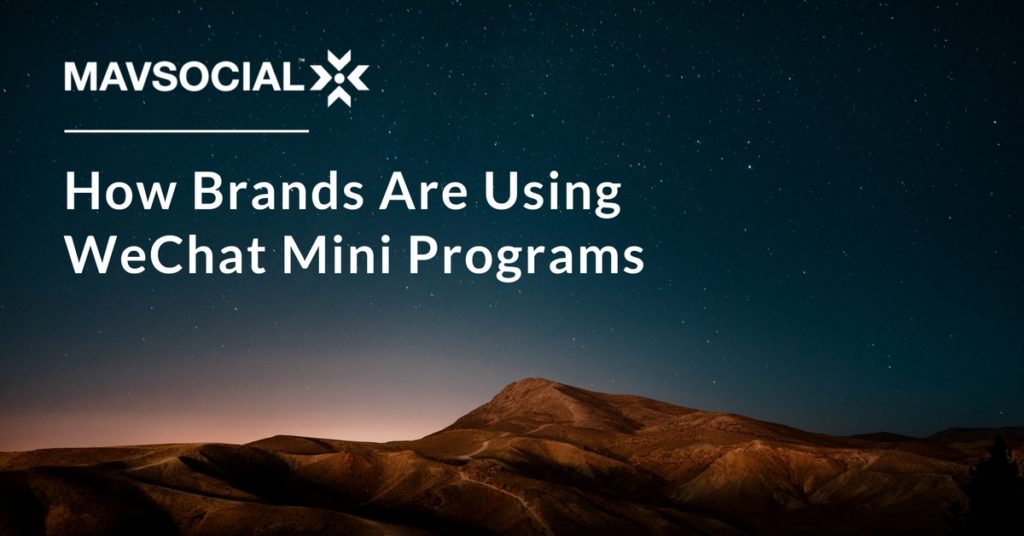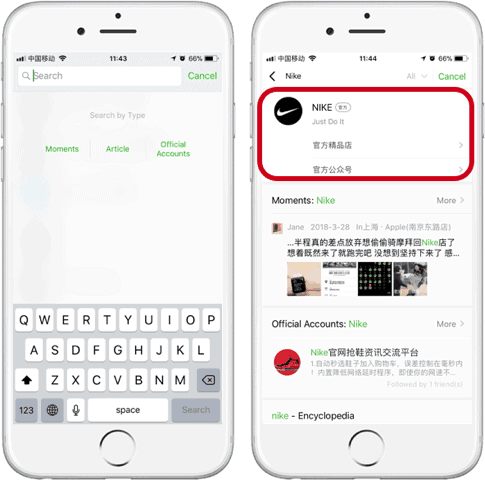China’s most popular app, WeChat, with over 1 billion users, has international brands scrambling to optimize the way in which they reach and engage with their audience through this all-encompassing platform.
If you haven’t yet familiarized yourself with WeChat and how it can be used by brands to connect with Chinese consumers, read our ‘WeChat Marketing Guide‘.
Up until now, brands have only been able to create an Official Account to interact and engage with fans, but in the beginning of 2017 WeChat announced the release of mini programs.
What exactly is a WeChat mini program?
If you look at the general trend of smartphone users, the majority aren’t downloading apps as much as they did 5 years ago.
This, coupled with a bit of a power struggle between Tencent and the Apple Store, makes it appropriate for Tencent to invest in developing its own app ecosystem within its golden egg – WeChat.
A mini program runs within WeChat, and is smaller than a typical app, taking up less than 10 megabytes. They are fast, and can usually be developed quickly at a lower cost.
Now if you’re thinking that in 5 years people in China will only be accessing apps through WeChat mini apps – this most likely will not happen.
Thomas Graziani, co-founder of a WeChat marketing agency start-up called WalktheChat, says “Mini programs will not replace the mobile app as you know it, but they are very effective in helping apps like games to acquire new users.”
When mini programs were first launched in January of 2017, it was unclear how this was going to change the WeChat ecosystem, and the hype that surrounded the much-anticipated launch quickly died down.
It was not until the end of 2017 that mini programs essentially went viral and began to gain traction.
In December of 2017 WeChat released mini games, and one of the most popular games, 跳一跳 or literally translated as ‘jump jump’ went viral in a matter of days, gaining 400 million users within the first 3 days.
Tapping into China’s love for gamification was a smart move by WeChat.
With over 517 million gamers, gamification is a popular tactic used by brands to swiftly raise brand awareness, engage and convert fans.
The release of mini games, combined with a new app update which moved mini programs to a bar above users’ personal messages made the feature much more visible and much more enticing to brands.
At the beginning of 2018 in January at the WeChat Annual Conference in Guangzhou, Allen Zhang, the creator of WeChat made 8 major announcements.
Of those 8 announcements, Zhang announced that mini programs will be a focus of the of the WeChat team this year, along with improving the search function of WeChat (more on why this matters later).
In January, Zhang announced that there were currently 580,000 published mini programs with 170 million users, by now we can only assume this number has increased significantly with the rush to develop mini programs and the increase in popularity.
How does a mini program differ from an Official Account
Discovery
An Official Account can be found by scanning or extracting a QR code, searching for the account ID within WeChat, or through the sharing of a contact card.
While mini programs have several more touchpoints that make them easily discoverable and very sticky.
A user can see and launch a mini program directly from an Official Account either from a menu or from when they first follow the account.
Mini programs can also be shared within an article or a group chat and will generate a visually appealing thumbnail – as opposed to an Official Account which has to be shared as a QR code or a contact card.
Once a mini program has been clicked on, it will automatically be stored above a users’ personal messages, as well as in the mini program folder, making mini programs incredibly sticky.
Engagement
In our previous article, we discussed the different types of Official Accounts brands can have in order to interact with fans – Subscription Accounts and Service Accounts.
With Official Accounts, brands can engage with fans when they first follow the account, as well as for as long as that user remains a follower by sending articles that may appear among a user’s personal messages.
However, the functionality of Official Accounts is inherently limited, while mini programs can be built to a brand’s specific needs – there are virtually endless ways that a mini program can be built to engage with fans.
Mini programs have the ability to offer membership programs, loyalty systems, points or rewards, which is increasingly valuable in China as brand loyalty becomes harder and harder foster among consumers.
Chinese consumers have such a variety of options, and from so many different platforms that if they do not feel they are receiving any type of personalized care – they will move on.
This is where loyalty programs come in – and mini programs offer a much better solution than previously available through WeChat.
In terms of which is better, an Official Account, or mini programs, this is extremely dependent on the brand and the needs of such brand (scroll to the end for more on this).
Mini programs and ecommerce
There is no disputing it – mini programs have quite impressive capabilities when it comes to e-commerce.
While Official Accounts allow for slightly more options in terms of linking to other platforms (except for Taobao and Tmall), mini programs offer a seamless purchasing experience within a mini program store.
Why mini programs are great for KOLs
Because advertising options are rather limited on Wechat, KOLs, (Key Opinion Leaders) or influencers are often used by brands to promote content or products (why influencers are so much more effective in China).
Typically, Weibo KOLs had a much easier time pushing e-commerce, as they are able to link directly to Taobao or Tmall from Weibo, while within WeChat, consumers had to take multiple steps in order to complete a purchase.
For many WeChat KOLs this was a huge pain point, as WeChat KOLs are usually producing much more long-form, informative content and develop a strong foundation of trust with fans – now with mini programs they are able to capitalize on their strong relationship with fans, and the ease in which consumers can make purchases.
A high profile Chinese KOL, Gogoboi, was one of the first KOLs to begin using mini programs for ecommerce effectively.
His fans are easily able to access his mini program which features popular luxury brands. You can see how easy it is to access the mini program from his subscription account and to purchase an item.
Sounds great, but do you really need one?
Similar to the buzz surrounding WeChat itself, many foreign brands are hearing about mini programs, and without fully understanding the ecosystem, are asking for one to be made for their brand – but is this really necessary?
Factors to consider
Investment from WeChat
Not only did Allen Zhang specifically announce that mini programs would be a top priority this year, but he also announced the increased investment in the WeChat Search function.
How is this connected?
If you type keywords, or the name of a brand into the search bar within WeChat, the first search results are now mini programs.
This is huge for brands that have a mini program – especially considering that all it takes is one click on that mini program, and it then goes into a users folder automatically and stays there unless they go in and delete it.
The visibility and stickiness of WeChat is huge for brands on a platform that is notorious for being a “walled garden” with limited options for brands in terms of engagement and promotion.
For this reason, it can be incredibly useful for brands to invest in a mini program.
Engagement
Even though Official Accounts are able to engage followers by sending out articles either daily, or 4 times per month depending on the account, article read rates are on the decline, as well as conversion rates.
The ‘read more’ link at the bottom of a WeChat post has an average CTR of a dismal 1%.
Brands need to be savvy about how they are engaging fans.
Is a mini program the best way to do this?
If you are serious about marketing in China, you’ll make a mini program to either solve a problem for your target consumer, provide access to a special service or program or has e-commerce capabilities.
Don’t have one just to get in the game, know your target audience and provide real value.






